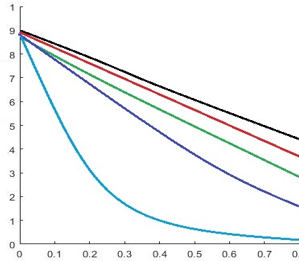Mathematical Modeling of Blood Flow Dynamics in the Cardiovascular System: Assumptions, Considerations, and Simulation Results
Abstract
The study of fluid dynamics is crucial to understanding fluid flow in the human body, and cardiovascular physics places a lot of concentration on blood flow modelling. Nevertheless, the models that have been created thus far with three-dimensional analysis are extremely complex. This research work offers study of blood pressure, flow and other flow-related parameters. Modelling artery was an extensible circular pipe with oscillating blood flow. Understanding factors that could lead to high blood pressure as one of the reasons for studying blood flow. The cardiovascular system equation is a straightforward differential equation that was developed under certain assumptions using Navier-Stokes equations. Generic study of normal blood flow was then created by applying some assumptions to the equation for the cardiovascular system. Poisuelli's equation was then used to extend this model to account for normal blood pressure. Upon completion of this study, an analysis was conducted to ascertain the validity of the suggested problem. According to the analysis, the model is able to account for various blood pressure and other flow characteristics of blood.
Full text article
References
Acheson, D. J. (1991). Elementary fluid dynamics. Acoustical Society of America.
Ehrlich, A., & Schroeder, C. L. (2013). Medical terminology for health professions. Delmar, Cengage Learning.
Faris, O. P., et al. (2003). Novel technique for cardiac electromechanical mapping with magnetic resonance imaging tagging and an epicardial electrode sock. Annals of Biomedical Engineering, 31, 430–440.
Hunter, P. J., Pullan, A. J., & Smaill, B. H. (2003). Modeling total heart function. Annual Review of Biomedical Engineering, 5(1), 147–177.
Katila, T., et al. (2001). Functional Imaging and Modeling of the Heart.
Kilner, P. J., et al. (2000). Asymmetric redirection of flow through the heart. Nature, 404(6779), 759–761.
Lassen, N. A., Ingvar, D. H., & Skinhøj, E. (1978). Brain function and blood flow. Scientific American, 239(4), 62–71.
Liu, C. H., et al. (1998). Airway mechanics, gas exchange, and blood flow in a nonlinear model of the normal human lung. Journal of Applied Physiology, 84(4), 1447–1469.
Magnin, I., et al. (2003). Functional imaging and modeling of the heart (FIMH’03), Lecture notes in Computer Science.
Masood, S., et al. (2000). Investigating intrinsic myocardial mechanics: the role of MR tagging, velocity phase mapping, and diffusion imaging. Journal of Magnetic Resonance Imaging, 12(6), 873–883.
McCulloch, A., et al. (1998). Computational biology of the heart: from structure to function. Progress in Biophysics and Molecular Biology, 69, 153.
Munson, B. R., et al. (2015). Fundamentals of Fluid Mechanics (8th ed.). John Wiley & Sons.
Noble, D. (2004). Modeling the heart. Physiology, 19(4), 191–197.
Pedley, T. J. (2003). Mathematical Modeling of arterial fluid dynamics. Journal of Engineering Mathematics, 47, 419–444.
Rhode, K. S., et al. (2005). A system for real-time XMR guided cardiovascular intervention. IEEE Transactions on Medical Imaging, 24(11), 1428–1440.
Sapna Ratan Shah, Mo. Sadique, Sunil Kumar Sharma, Sardar M. N. Islam, “Effect of Significant Parameters on Squeeze Film Characteristics in Pathological Synovial Joints”, Mathematics (MDPI), 11 (1468) 1-23, (2023).
Sapna Ratan Shah, Pushkar Kumar, “A Hydromechanical Perspective to Study the Effect of Body Acceleration through Stenosed Artery”, International journal of mathematical engineering and management sciences, Volume. 6 No. 5, pp. 1381-1390, 2021.
Sapna Ratan Shah, Rohit Kumar “Study of blood flow with suspension of nanoparticles through tapered stenosed artery”, Global Journal of Pure and Applied Mathematics, Volume 13(10), pp. 7387-7399, (2017).
Sapna Ratan Shah “Significance of Aspirin on Blood Flow to Prevent Blood Clotting through Inclined Multi-Stenosed Artery”, Letters In Health and Biological Sciences, Volume 2(2), pp. 97-100, (2017).
Streeter, V. L., Wylie, E. B., & Bedford, K. W. (1998). Fluid Mechanics (9th ed.). McGraw-Hill Science/Engineering/Math.
Wang, G., Peng, S., & Jiang, L. (Eds.). (2020). Advances in Multiphase Flow and Heat Transfer. Springer.
Wang, Q., et al. (2023). Fluid Dynamics: Theory, Computation, and Applications. John Wiley & Sons.
Xia, L., & Huo, M. (2003). Analysis of ventricular wall motion based on an electromechanical biventricular model. In Computers in Cardiology, 2003, pp. 315–318.
Yang, B.-H., Asada, H. H., & Zhang, Y. (1999). Cuff-less continuous monitoring of blood pressure using a hemodynamic model. Home Automation & Healthcare Consortium-Progress Reports, 2(3), 1–22.
